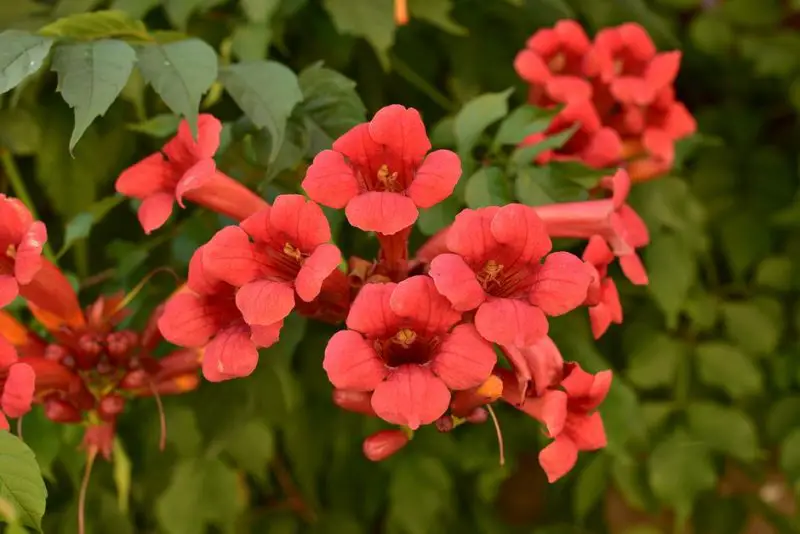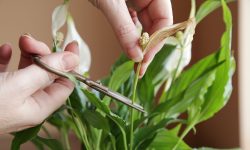Trumpet vine, with its vibrant trumpet-shaped flowers, is a favorite in many gardens. Its rapid growth and striking blooms attract hummingbirds and butterflies. Propagating trumpet vine allows gardeners to expand their collection and enjoy abundant floral displays year after year.
Understanding the propagation process is crucial for success. Proper techniques help avoid common mistakes that can stunt growth or kill cuttings. This guide offers essential tips for propagating trumpet vine effectively. From preparing cuttings to caring for rooted plants, gardeners will learn how to ensure healthy growth, strong roots, and long-lasting blooms. Following these steps guarantees a flourishing, visually stunning garden.
Understanding Trumpet Vine Propagation

Propagating trumpet vine allows gardeners to increase their plant collection and enjoy its vibrant blooms across larger spaces. There are several methods for propagation, including stem cuttings, layering, and seed propagation. Each method has its advantages, but stem cuttings are the most reliable for producing strong, healthy plants quickly. Understanding how the vine grows and develops roots is essential before beginning any propagation effort.
Stem cuttings taken from healthy, mature canes are ideal. These cuttings should be semi-hardwood, firm yet flexible, taken during the growing season for the best rooting success. Removing lower leaves and dipping the cut ends in rooting hormone encourages rapid root development. Proper medium and humidity are critical to prevent rot and ensure consistent growth. Monitoring cuttings for early signs of disease or stress increases the likelihood of success.
Layering is another effective method, especially for spreading vines in existing garden areas. By gently bending a low-growing cane into the soil and securing it, roots can develop naturally while still attached to the parent plant. Seeds can also be used, but germination rates are slower, and plants take longer to mature. Understanding the strengths and limitations of each propagation method helps gardeners choose the approach that best fits their needs and garden conditions.
Choosing the Right Location for Transplanted Plants
Selecting an optimal location is crucial for the long-term success of transplanted trumpet vine cuttings. These plants thrive in full sunlight with at least six to eight hours of direct light daily. Well-draining soil is essential to prevent root rot while providing enough moisture for healthy growth. Slightly acidic to neutral soil pH supports nutrient absorption and vigorous flowering.
Consider spacing when planting multiple trumpet vines. Crowded plants reduce airflow, increasing the risk of fungal diseases. Position cuttings near trellises, fences, or arbors for structural support. Adequate space also allows each plant to receive sufficient light, which is critical for photosynthesis and bloom production.
Regular monitoring of the location helps ensure optimal conditions. Adjust watering schedules based on seasonal rainfall and temperature fluctuations. Mulching around the base helps conserve moisture and suppress weeds, improving overall plant health. By choosing the right location, gardeners set the foundation for vigorous growth, abundant blooms, and a thriving, low-maintenance trumpet vine garden.
Preparing Cuttings for Successful Rooting
Successful propagation of trumpet vine begins with selecting and preparing the right cuttings. Choose healthy, disease-free canes that are mature but still flexible. Semi-hardwood cuttings taken during the growing season are ideal. Remove any damaged or weak stems to increase the chances of strong root development.
Once selected, cut sections about six to eight inches long, making clean, precise cuts just below a leaf node. Strip leaves from the lower half to reduce moisture loss and improve rooting potential. Dipping the cut end in a rooting hormone can stimulate root growth and speed up establishment. Proper preparation ensures that the cutting has maximum energy for new root and shoot development.
After treatment, plant the cuttings in a well-draining medium, such as a mix of sand and peat moss. Maintain consistent moisture without waterlogging to prevent rot. Place cuttings in a warm, bright location with indirect sunlight. Covering with a plastic dome or bag can help maintain humidity, which encourages root formation. Regular monitoring for disease or stress ensures higher success rates. Properly prepared cuttings set the foundation for healthy, vigorous trumpet vine plants that will thrive in the garden.
Transplanting Rooted Cuttings
Once trumpet vine cuttings have developed strong roots, it is time to transplant them into larger containers or directly into the garden. Choose a location with full sun and well-draining soil. The soil should be fertile and slightly acidic to support vigorous growth and abundant blooms. Proper site selection ensures that transplanted cuttings establish quickly and thrive.
Carefully remove the rooted cuttings from their propagation medium, taking care not to damage delicate roots. Gently loosen the roots if they are compacted, and plant them at the same depth as they were growing previously. Water thoroughly after transplanting to settle the soil around the roots and reduce transplant shock. Mulching around the base helps retain moisture and regulates soil temperature.
After transplanting, monitor the plants closely for the first few weeks. Ensure consistent watering and protect them from strong winds or harsh sunlight. Avoid fertilizing immediately; wait until the plants show signs of new growth. With proper care, rooted trumpet vine cuttings will adapt quickly to their new environment, develop strong stems, and produce vibrant, trumpet-shaped flowers that attract pollinators and enhance the beauty of any garden.
Fertilization Strategies for Healthy Growth
Proper fertilization promotes strong root development and prolific flowering in propagated trumpet vines. Newly transplanted cuttings benefit from a balanced, slow-release fertilizer that supplies nitrogen, phosphorus, and potassium in moderate amounts. Avoid over-fertilizing, which can lead to excessive leafy growth and fewer blooms.
Timing is crucial. Begin fertilization once cuttings show signs of new growth, usually two to three weeks after transplanting. Foliar feeding can supplement nutrients, particularly during the active growing season. Regular soil testing ensures nutrient levels remain adequate without causing toxicity.
Combining fertilization with other cultural practices enhances plant health. Consistent watering, proper sunlight, and strategic pruning all complement nutrient uptake. Following these fertilization strategies helps trumpet vines develop robust roots, strong stems, and vibrant, long-lasting flowers, ensuring a visually striking and resilient garden display.
Common Mistakes to Avoid
Selecting Poor-Quality Cuttings
One of the most frequent mistakes when propagating trumpet vine is using weak or unhealthy cuttings. Cuttings from diseased, damaged, or overly woody stems often fail to root or produce weak growth. Semi-hardwood stems taken during the growing season provide the best results. These stems are mature enough to have stored energy but still flexible enough to develop new roots efficiently.
Before taking cuttings, inspect each stem carefully for pests, discoloration, or mechanical damage. Remove leaves from the lower half to reduce water loss and concentrate energy on root formation. Healthy cuttings are more likely to survive transplantation and produce strong, vigorous plants. Investing time in selecting quality cuttings increases propagation success, ensures faster establishment, and leads to trumpet vines with abundant, long-lasting blooms.
Incorrect Planting Techniques
Another common error is improper planting depth and medium selection. Planting cuttings too deep can lead to rot, while planting too shallow prevents proper root anchorage. Cuttings should be planted at the same depth as in the propagation medium, with enough support to maintain upright growth. Soil should be well-draining to avoid waterlogging while retaining enough moisture for root development.
Using a mixture of sand and peat moss provides ideal conditions, encouraging roots to grow evenly. Covering cuttings with a plastic dome or bag maintains consistent humidity, which is crucial during the early rooting stage. Proper planting techniques significantly increase survival rates and promote strong, healthy trumpet vine plants that will thrive after transplantation.
Neglecting Aftercare
After planting, trumpet vine cuttings need careful, consistent care to establish successfully. Newly rooted cuttings are fragile and can be stressed by irregular watering, harsh sunlight, or pests. Regularly monitor for wilting, discoloration, or fungal infection and remove damaged leaves promptly. Maintain consistent soil moisture and moderate light, and apply balanced fertilizer once roots are established. Mulching helps retain moisture and regulate temperature. Proper aftercare ensures strong root development, vigorous growth, and eventually abundant, vibrant trumpet-shaped blooms, transforming delicate cuttings into thriving, visually striking plants that enhance any garden.
In addition to watering and nutrition, attention to environmental conditions is crucial. Protect cuttings from strong winds or sudden temperature fluctuations, which can damage tender stems. Regular inspection allows early detection of insect infestations or fungal problems, preventing further stress. Providing gentle support for weak stems encourages upright growth and prevents breakage. By combining these practices, gardeners can ensure their trumpet vine cuttings mature into healthy, well-structured plants capable of producing spectacular flowers season after season.
Troubleshooting Rooting Issues
Poor Root Development
A frequent problem in trumpet vine propagation is poor root development, which can stall growth and reduce survival rates. Even if cuttings appear healthy above ground, insufficient root formation prevents nutrient and water uptake. One common cause is low humidity or inconsistent moisture levels. Using a well-draining medium, such as a sand and peat moss mixture, ensures oxygen reaches the roots while preventing waterlogging. Excessively wet soil can cause rot, whereas overly dry conditions can desiccate the cutting.
Environmental factors like temperature and light intensity also influence rooting success. Cuttings thrive in warm, stable conditions between 70–75°F with indirect sunlight. Avoid direct, harsh sun, which can stress tender cuttings and cause leaf scorch. Maintaining consistent humidity through misting or covering cuttings with a transparent dome encourages root initiation. Patience is essential, as trumpet vine cuttings may take several weeks to establish a strong root system. Monitoring for early signs of stress and adjusting care accordingly increases the likelihood of producing vigorous, transplant-ready plants.
Stem Rot and Disease
Stem rot is a significant challenge during trumpet vine propagation. Overwatering, poor drainage, and fungal pathogens often cause cuttings to decay before roots form. Diseased tissue should be removed immediately, and fungicide applied to the propagation medium if necessary. Clean, sharp tools prevent contamination and reduce the spread of infection. Maintaining a sanitized workspace further minimizes the risk of disease.
Humidity management is critical. Covering cuttings with a plastic dome or bag retains moisture but can trap condensation, creating a breeding ground for fungi. Ensure some airflow to prevent excess dampness while still maintaining adequate humidity. Inspect cuttings daily for signs of rot, discoloration, or soft stems. Early intervention can save struggling cuttings, allowing them to develop strong roots. Properly managed cuttings not only survive the propagation stage but also develop into robust, healthy trumpet vine plants ready for transplantation and flowering.
Leaf Yellowing or Wilting
Leaf yellowing or wilting during rooting indicates stress that can compromise the cutting’s success. Common causes include inconsistent watering, too much direct sunlight, or nutrient deficiencies. Soil should remain consistently moist but never waterlogged, and light exposure should be indirect to prevent scorching. Monitoring the growing environment helps detect these stress factors early.
Additional care includes gentle airflow to reduce mold and disease risk while maintaining adequate humidity for root formation. Removing yellowed or wilted leaves focuses the cutting’s energy on healthy shoots and roots, increasing the chances of survival. Providing a balanced, diluted fertilizer once roots begin forming supports strong growth. By addressing these early signs, gardeners can rescue stressed cuttings and ensure they mature into vigorous, flowering trumpet vines capable of thriving in the garden for years.
Seasonal Care Tips for Propagated Plants
Spring Care for New Plants
Spring is a critical season for recently propagated trumpet vines. As temperatures rise, new roots and shoots emerge, requiring consistent moisture and nutrients to support vigorous growth. Water the plants regularly, keeping the soil evenly moist without waterlogging. Applying a balanced fertilizer rich in nitrogen, phosphorus, and potassium encourages strong stems, healthy foliage, and future flowering potential. Mulching around the base helps retain soil moisture and suppress weeds.
Monitor young plants for pests and fungal infections during this active growth phase. Inspect leaves and stems regularly, removing damaged or diseased tissue immediately. Provide support for climbing vines by guiding flexible stems along trellises or arbors. Adequate airflow between stems reduces the risk of fungal disease and promotes even growth. By following these spring care strategies, propagated trumpet vines develop robust root systems, healthy shoots, and the foundation for abundant summer blooms.
Summer Care for Optimal Blooming
Summer care focuses on sustaining vigorous growth and maximizing flowering. Ensure trumpet vines receive full sunlight, ideally six to eight hours daily, to encourage prolific blooms. Water deeply during dry periods to prevent stress, but avoid overwatering, which can lead to root rot. Fertilize lightly with a bloom-boosting fertilizer to support flower production without encouraging excessive leafy growth.
Prune selectively to remove weak or overcrowded stems. Regular inspection for pests such as aphids or spider mites allows early intervention, preventing damage that could reduce flowering. Providing proper support structures and tying stems as they grow horizontally or vertically promotes balanced development. Following these summer care practices ensures propagated trumpet vines produce abundant, vibrant, trumpet-shaped flowers that attract pollinators and enhance the visual appeal of the garden.
Fall Preparation for Dormancy
As autumn approaches, trumpet vines need careful preparation for dormancy. Gradually reduce watering as temperatures drop and growth slows. Removing dead, damaged, or diseased foliage prevents pests and fungal infections from overwintering. Mulching around the base helps insulate the roots, retain soil moisture, and protect the plant from sudden temperature changes. This layer of organic material creates a stable microenvironment for the roots, reducing stress during colder months.
In addition to soil and foliage management, consider the structural support of climbing stems. Tie any flexible canes securely to trellises or arches to prevent wind or frost damage. Inspect the plant for weak or brittle stems and prune minimally to remove only the most vulnerable growth. Proper preparation in the fall ensures trumpet vines survive winter in a healthy state, allowing them to resume vigorous growth in the following spring.
Winter Protection and Monitoring
During winter, trumpet vines enter dormancy and require minimal care but careful monitoring. Avoid fertilizing or heavy pruning, as dormant plants cannot recover quickly. Keep an eye out for frost damage or broken stems, and protect exposed areas with burlap, straw, or other insulating materials. This protective layer shields stems and buds from extreme cold while maintaining airflow to prevent mold or rot.
Monitoring for signs of stress is essential, even during dormancy. Check periodically for pests that might find shelter under mulch or around the base. Ensure soil moisture remains adequate but not waterlogged. By providing protection and monitoring, propagated trumpet vines remain healthy and structurally sound, ready to produce robust growth and abundant blooms when spring arrives.
Companion Planting and Garden Benefits
Integrating trumpet vines with other garden plants can enhance aesthetics and ecological balance. Planting nectar-rich flowers nearby attracts pollinators like bees and hummingbirds, boosting overall garden biodiversity. Companion plants with different bloom times can extend color and interest throughout the season.
Additionally, companion planting can help manage pests naturally. Certain herbs or flowering plants repel insects that might otherwise target trumpet vines. By considering plant height, growth habit, and sunlight requirements, gardeners can create a visually appealing, low-maintenance garden ecosystem that supports healthy trumpet vine growth.
Careful selection of companion plants also improves soil health and microclimate around trumpet vines. Deep-rooted plants can enhance soil structure, while groundcovers help retain moisture and suppress weeds. Taller companions provide partial shade, protecting young cuttings from intense midday sun. Additionally, layering plants with varying textures and colors creates a dynamic visual display, making the garden more attractive to both humans and pollinators. By planning companion planting thoughtfully, gardeners not only support trumpet vine growth but also encourage a resilient, biodiverse garden environment that thrives year-round.
FAQ About How to Propagate Trumpet Vine
How long does it take trumpet vine cuttings to root?
Trumpet vine cuttings typically develop roots within three to six weeks, depending on environmental conditions. Warm temperatures, high humidity, and indirect sunlight speed up the process. Using a well-draining propagation medium and applying rooting hormone can further improve success rates and ensure vigorous, healthy plants ready for transplantation.
Can trumpet vine be propagated from seeds?
Yes, trumpet vine can be grown from seeds, but this method is slower and less reliable than stem cuttings. Seeds may take several weeks to germinate and require specific conditions, such as warmth and consistent moisture. Propagation from cuttings produces faster, stronger plants with earlier flowering potential.
How often should I water newly rooted trumpet vine cuttings?
Newly rooted cuttings need consistent moisture without waterlogging. Water deeply when the soil begins to dry, maintaining a slightly damp environment. Too much water can cause stem rot, while too little slows root development. Adjust watering frequency according to temperature and humidity levels to encourage strong, healthy growth.
What type of soil is best for trumpet vine propagation?
A well-draining medium is essential. A mix of sand and peat moss provides adequate moisture retention while allowing oxygen to reach developing roots. Avoid heavy clay soils that retain water excessively, as they can lead to root rot. Fertile, slightly acidic soil supports healthy root and shoot growth for vigorous flowering plants.
How do I protect trumpet vine cuttings from pests and diseases?
Inspect cuttings regularly for signs of insect activity or fungal infections. Remove damaged leaves promptly and maintain good airflow around plants to reduce humidity-related disease. Using sanitized tools and clean propagation containers prevents contamination. Early intervention ensures strong, healthy plants capable of thriving and producing vibrant blooms.
Conclusion
Propagating trumpet vine successfully requires attention to detail, proper preparation, and consistent aftercare. By selecting healthy cuttings, using the right rooting medium, and monitoring environmental conditions, gardeners can avoid common mistakes and overcome rooting challenges. Seasonal care ensures strong growth, vibrant blooms, and long-lasting plants. With patience and proper techniques, even novice gardeners can transform delicate cuttings into vigorous, flowering trumpet vines. Following these essential tips guarantees a thriving, visually stunning addition to any garden, attracting pollinators and enhancing outdoor spaces year after year.






